Lactose Free Food Market Size and Trends
The lactose free food market is estimated to be valued at USD 20.66 Bn in 2025 and is expected to reach USD 41.06 Bn by 2032, growing at a compound annual growth rate (CAGR) of 10.3% from 2025 to 2032.
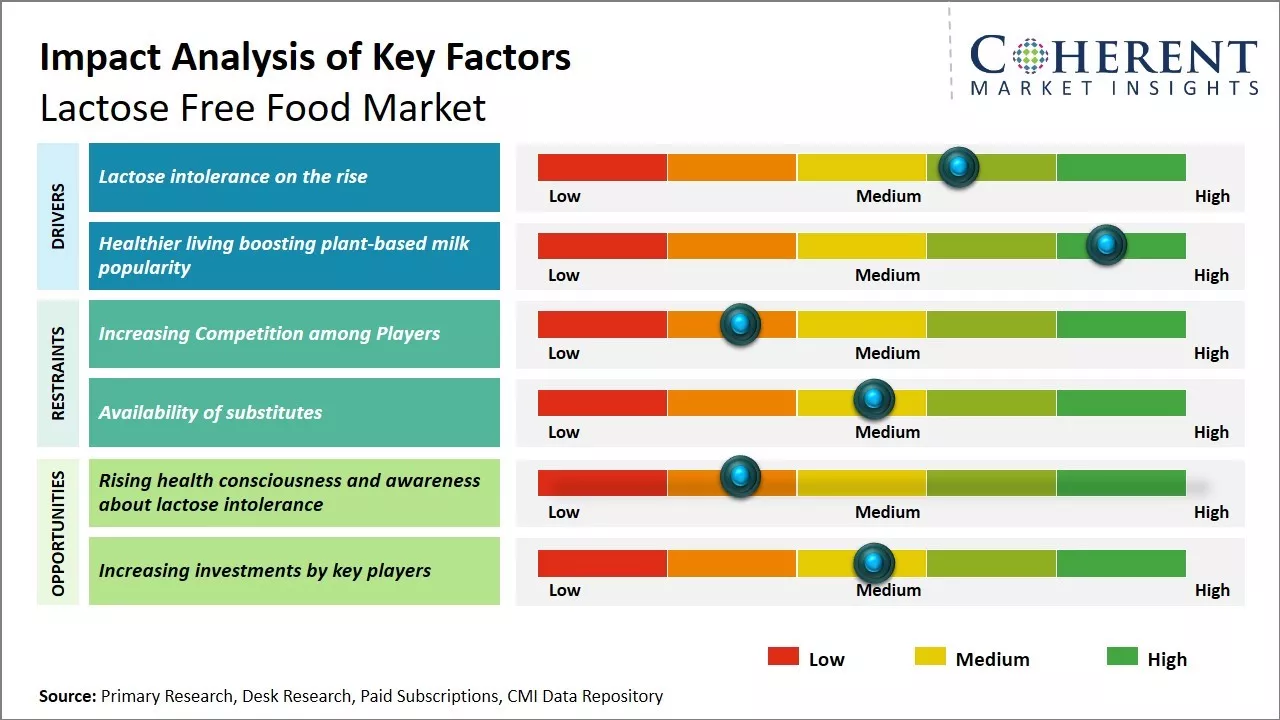
Discover market dynamics shaping the industry: Download Free Sample
The demand for lactose free food is increasing globally due to rising incidence of lactose intolerance and milk allergy. Consumers are more aware now about the benefits of lactose-free diet and products. Moreover, changing lifestyle and increasing fast food consumption have been major factors for lactose intolerance. Hence, more number of people are opting for lactose-free variants of milk, cheese, yogurt, and other dairy products. Many food companies have launched innovative lactose-free products to cater to this rising demand. The lactose free food market is expected to grow steadily during the forecast period driven by increasing health consciousness and availability of various lactose-free substitutes.
Lactose intolerance on the rise
As the prevalence of lactose intolerance continues to increase around the world, more consumers are seeking out alternatives to dairy that won't cause digestive issues. For instance, experts estimate that about 68 percent of the world's population has lactose malabsorption. Lactose intolerance refers to the inability to properly digest lactose, the natural sugar found in milk and dairy products. This is because many people, especially those of Asian, African, and Native American descent, do not produce enough of the lactase enzyme as adults to break down the lactose. Symptoms like gas, bloating, cramps, and diarrhea often occur after the consumption of milk or dairy. Recent genetic studies suggest that around two-thirds of the global population has a reduced ability to digest lactose after infancy. While prevalence rates vary widely by region and ethnicity, virtually no population is immune to the condition. Even in western countries where dairy has long been a dietary staple, the numbers of those who are lactose intolerant are significant and growing. Younger generations also appear more affected than older generations who have had dairy as lifelong part of their diets. With increasing globalization and migration, multi-ethnic cultures are also on the rise which portends greater awareness of food sensitivities like lactose intolerance.
Market Concentration and Competitive Landscape
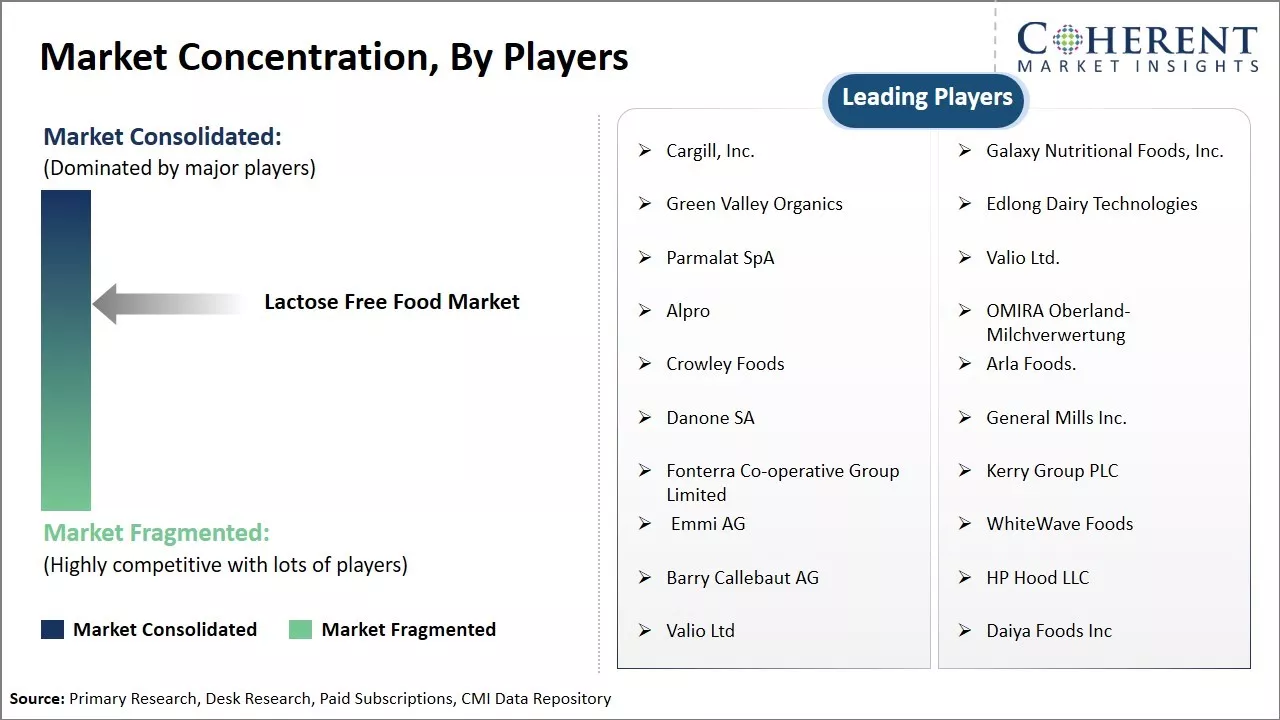
Get actionable strategies to beat competition: Download Free Sample
Healthier living boosting plant-based milk popularityModern consumers are becoming increasingly health-conscious and seeking out plant-based substitutes perceived as more natural and sustainable choices than dairy. Traditional animal milk requires considerable environmental and resource impacts in production. Meanwhile, plant-based milks like soy, almond, oat, and coconut and rice varieties are often viewed as “cleaner” options free of dairy's sugars, hormones, and saturated fats. As diets shift toward plant-based eating for health and ethical reasons, interest in nutrient-rich non-dairy milks has surged dramatically.
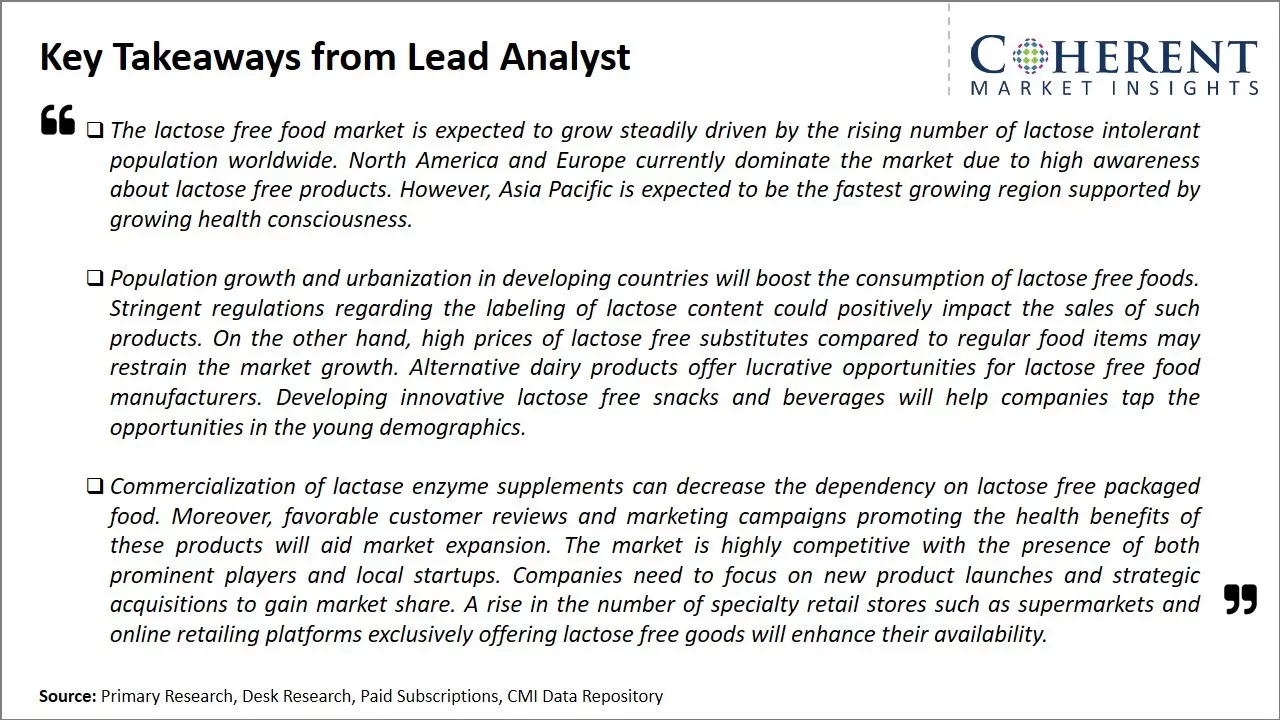
To learn more about this report, Download Free Sample
Market Challenges: Increasing competition among playersOne of the main challenges faced by the lactose free food market is increasing competition among players as the market grows. With many new entrants offering similar substitute dairy products, it is becoming difficult for companies to differentiate their products. Additionally, maintaining taste and texture similar to regular dairy products while removing lactose requires extensive research and testing, driving up costs. This also poses supply chain challenges to source non-dairy alternatives on a large scale.
Market Opportunities: Rising health consciousness and awareness about lactose intolerance
The market has seen rising health consciousness and awareness about lactose intolerance. There is a growing demand for special dietary products that are easy to digest. With about 65% of the world's adult population being lactose intolerant, targeting this large consumer base presents a major opportunity. Moreover, lactose free variants of popular snack items and beverages are gaining popularity beyond those with intolerances.
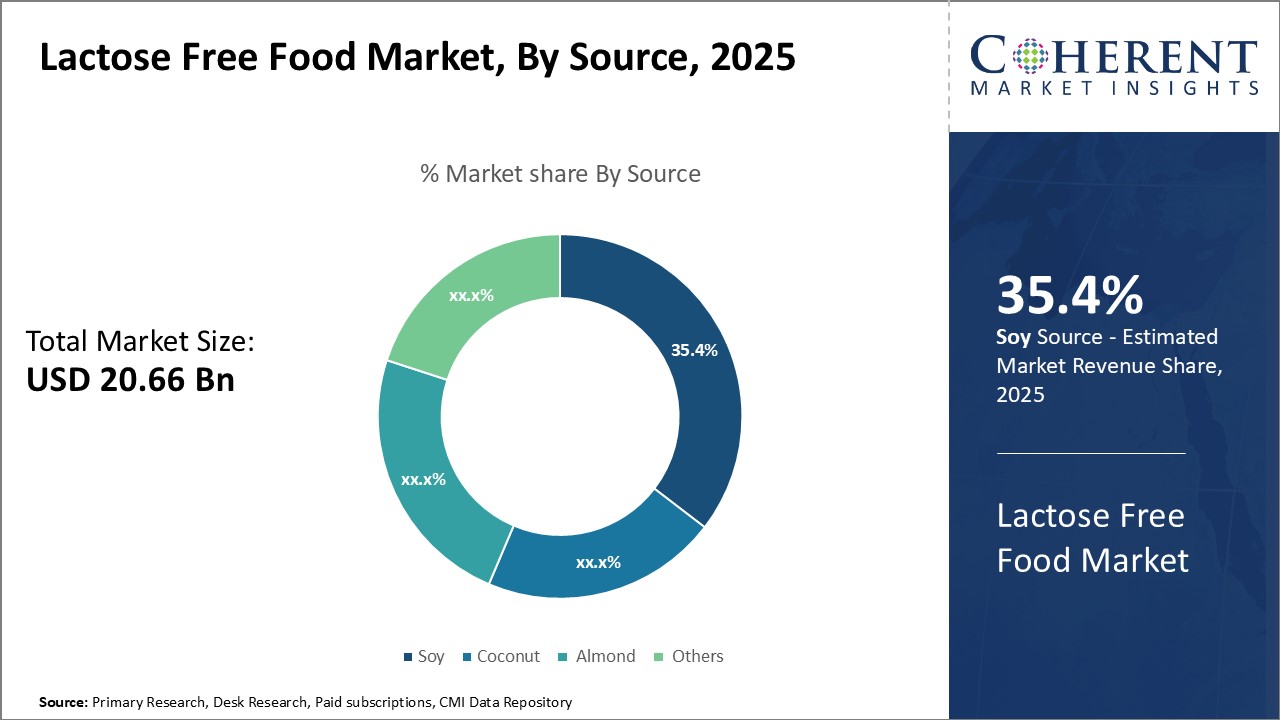
Discover high revenue pocket segments and roadmap to it: Download Free Sample
Insights, by Source: Rising Demand for Plant-Based Proteins Drives Soy DominanceIn terms of source, soy contributes 35.4% share of the lactose free food market due to the rising popularity of plant-based proteins. Consumers are increasingly seeking out non-dairy options made from legumes and nuts instead of animal products. Soy milk, yogurt, cheese, and other soy-based products help meet the daily protein needs of both the lactose intolerant population as well as flexitarians and vegans. Soy is considered a complete plant protein as it contains all nine essential amino acids. Its nutritional profile also includes minerals, fiber, vitamins and healthy fats. The positive health halo around soy has made it a top alternative for those avoiding dairy. Soy milk in particular has been able to imitate the taste and texture of cow's milk very closely, helping it gain widespread acceptance. Manufacturers have also innovated new soy-based foods and beverages to suit evolving tastes. Culturally, soy has deep roots in Asian diets and cuisine for thousands of years. Its popularity as a non-dairy option has now spread globally with rising Asian influence. Ease of production is another factor contributing to soy's market dominance as soybeans can be processed relatively simply into various forms like milk, yogurt and cheese through straining and culturing. This has kept production costs low compared to other plant-based alternatives.
Insights, by Product Type: Convenience and Familiar Formats Drive Dairy's Leading Share
In terms of product type, lactose-free dairy contributes 37.3% share of the market owing to consumer preference for familiar formats. Dairy products such as milk, yogurt, cheese, and butter are ingrained in daily diets and cuisines globally. Their removal due to lactose intolerance can significantly impact nutrition as well as lifestyles. Lactose-free versions of popular dairy items successfully address this issue by eliminating digestive discomfort while retaining beloved textures, flavors, and applications. Products like lactose-free milk are often used cup for cup as a direct substitute in recipes and routines. This ease of substitution maximizes convenience for busy consumers. For the same reason, lactose-free variants of natural yogurt and cheese enjoy strong demand as they allow seamless enjoyment of meals and snacks. Familiarity also breeds trust in product quality and consistency. Familiar dairy items deliver expected sensory experiences whether naturally produced or lactose-free. Decades of refinement have made formats like milk, yogurt and cheese reliable staples that are widely stocked and endorsed. As a result, lactose intolerant consumers are highly receptive towards tried-and-tested lactose-free dairy over novel options from other categories which may seem less foolproof. Thus, the popularity of lactose-free dairy emanates from its success in providing comfortable continuity to age-old dietary traditions despite digestive barriers. Its share of the market remains dominant by satisfying a deep consumer need for convenience via recognizable and reliable goods. Ongoing innovations will serve to enhance this category further.
Insights, by Distribution Channel: Growing supermarkets and hypermarkets segment owing to advantages in credibility and assortment
In terms of distribution channel, supermarkets and hypermarkets contribute 42.8% of the market share due to advantages in credibility and assortment. As the dominant conventional retailers globally, they have decades of brand equity and industry stature accumulated through expertise in sourcing, marketing, and operations. This inherent brand trust encourages consumers to shop hypermarket private label lactose-free items with confidence in dependable quality standards. Their enormous shelf and cooler capacities also enable a breadth of options across all major product types, brands and subcategories like fat-free, sugar-free, or organic variants. No other channel rivals hypermarkets’ assortments at present. Moreover, hypermarkets appeal to those intimidated by the learning curve for specialized products. With dedicated lactose-free sections for self-servicing, they educate shoppers through expansive product displays. Staff can readily answer questions or recommend substitutes at different price-points. Such handholding bolsters adoption rates. As online shopping gains momentum, leading hypermarket grocers have established robust e-commerce platforms where consumers find familiar favorites. Search, filtering and review functions further simplify navigating extensive lactose-free catalogs digitally from home comforts. These hypermarket online shops directly transfer the confidence of their physical stores online. Therefore, between unmatched variety furnished through expertise as well as the dependability factor instilled over decades, supermarkets and hypermarkets will stay centrally positioned as consumers expand habits across virtual and brick-and-mortar domains alike. Their experience advantage leaves little incentive to entrust specialized needs elsewhere as yet.
Regional Insights
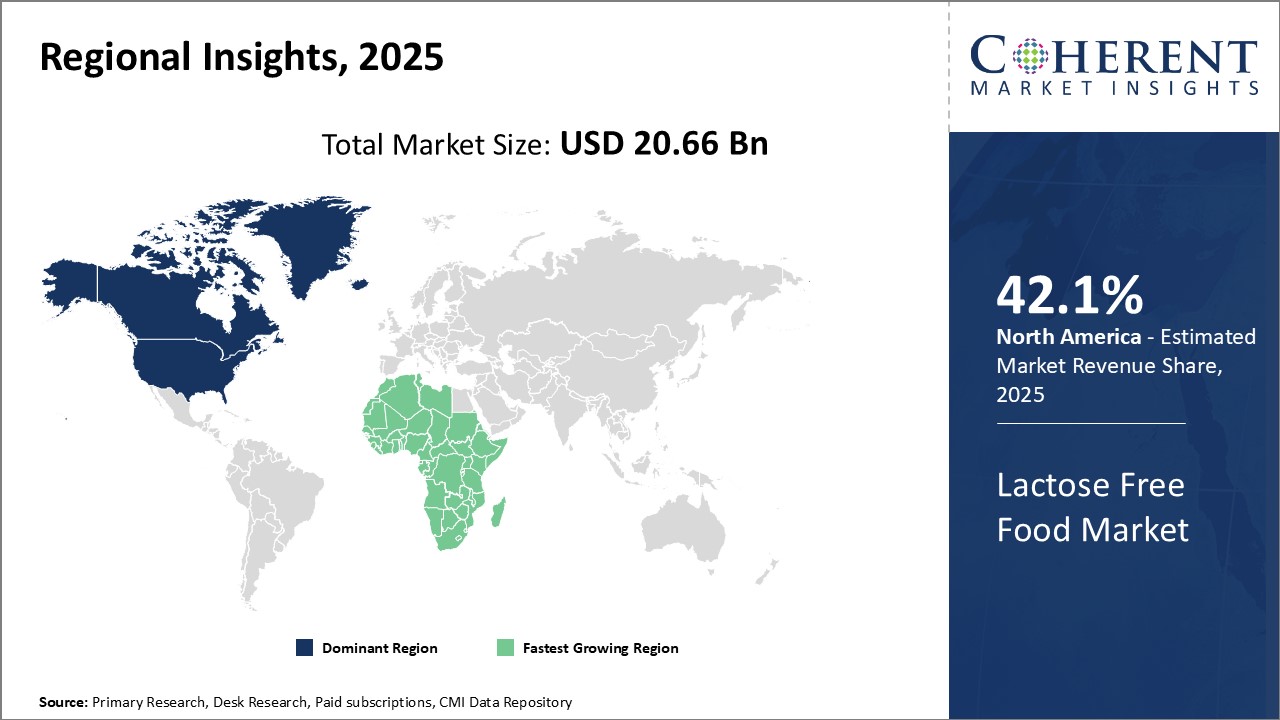
Need a Different Region or Segment? Download Free Sample
North America has established itself as the dominant market for lactose free foods with 42.1% of the market share. The large size of the market in the U.S. can be attributed to the growing incidence of lactose intolerance among consumers, especially those of Hispanic, Asian, and African American descent. Studies show that about 68.5% of Hispanic Americans and 75.5% of African Americans lack the enzyme lactase needed to digest lactose after infancy. Additionally, consumers are becoming increasingly aware of various digestive issues caused by dairy consumption. This has led to high demand for dairy alternatives and foods made with non-dairy milk substitutes like almond milk, coconut milk and oat milk. Major food companies have had a strong presence in the North American market for many years due to the opportunity for high profits. They have established supply chains and distribution networks to ensure wide availability of lactose free products across both retail and foodservice channels. Manufacturers offer a diverse range of lactose free milk, yogurt, and cheese and baked goods to cater to consumer needs. Consumers also prefer to purchase lactose free foods from large supermarket chains as they offer better pricing and discounts when compared to small specialty shops or online retailers.
The Asia Pacific region has emerged as the fastest growing market for lactose free foods. Countries like India and China have very large populations that are either lactose intolerant due to genetic factors or choose to avoid dairy due to dietary preferences or restrictions. The growing health and wellness trend among the middle class has boosted demand for specialized food products. The growing number of retail chains and e-commerce penetration is allowing greater availability of imported foreign brands as well as domestically produced lactose-free options at competitive price points. Imports of popular European lactose free foods into the Asia Pacific region have increased drastically. Key importers like Australia have also reduced tariffs on several European lactose free dairy items to make them more affordable for consumers. The strong economic growth witnessed by many developing Asian nations is lending greater purchasing power to consumers who are willing to pay extra for specialized health-oriented food products. Expect to see continued growth and new product innovations tailored to the Asia Pacific market due to its favorable dynamics and demographics.
Market Report Scope
Lactose Free Food Market Report Coverage
| Report Coverage | Details | ||
|---|---|---|---|
| Base Year: | 2024 | Market Size in 2025: | USD 20.66 Bn |
| Historical Data for: | 2020 To 2024 | Forecast Period: | 2025 To 2032 |
| Forecast Period 2025 to 2032 CAGR: | 10.3% | 2032 Value Projection: | USD 41.06 Bn |
| Geographies covered: |
|
||
| Segments covered: |
|
||
| Companies covered: |
Cargill, Inc., Galaxy Nutritional Foods, Inc., Green Valley Organics, Edlong Dairy Technologies, Parmalat SpA, Valio Ltd., Alpro, OMIRA Oberland-Milchverwertung, Crowley Foods, Arla Foods., Danone SA, General Mills Inc., Fonterra Co-operative Group Limited, Kerry Group PLC, Emmi AG, WhiteWave Foods, Barry Callebaut AG, HP Hood LLC, Valio Ltd, Daiya Foods Inc |
||
| Growth Drivers: |
|
||
| Restraints & Challenges: |
|
||
Uncover macros and micros vetted on 75+ parameters: Get instant access to report
Lactose Free Food Industry News
- In August 2023, Skyrrup announced the launch of lactose-free Greek yogurt with a protein content of 7.5 grams & made from A2 Cow Milk
- In June 2022, Provilac announced the launch of lactose-free cow milk in India
- In January 2020, The Coca-Cola Company acquired all the remaining stake in Fairlife LLC from its joint venture partner, Select Milk Producers, to meet the fast-changing demands of consumers for lactose-free products
- In April 2020, Valio and Palmer Holland (US) entered into a joint venture to offer lactose-free powders in the U.S. market
*Definition: The lactose free food market caters to consumers who cannot properly digest lactose, the natural sugar found in dairy products. This growing market provides a wide variety of tasty and nutritious food items that are specially processed or formulated to be naturally lactose-free. Products include milk, yogurt, cheese, baked goods, snacks and more - allowing those affected by lactose intolerance to enjoy foods while avoiding uncomfortable digestive symptoms.
Market Segmentation
- Source Insights (Revenue, USD Bn, 2020 - 2032)
- Coconut
- Soy
- Almond
- Others (Oats, Hemp)
- Product Type Insights (Revenue, USD Bn, 2020 - 2032)
- Lactose-free Dairy
- Lactose-free Bakery
- Lactose-free Confectionery
- Lactose-free Infant Formula
- Distribution Channel Insights (Revenue, USD Bn, 2020 - 2032)
- Supermarkets/Hypermarkets
- Convenience Stores
- Online Retail
- Regional Insights (Revenue, USD Bn, 2020 - 2032)
- North America
- U.S.
- Canada
- Latin America
- Brazil
- Argentina
- Mexico
- Rest of Latin America
- Europe
- Germany
- U.K.
- Spain
- France
- Italy
- Russia
- Rest of Europe
- Asia Pacific
- China
- India
- Japan
- Australia
- South Korea
- ASEAN
- Rest of Asia Pacific
- Middle East & Africa
- GCC Countries
- Israel
- Rest of Middle East & Africa
- North America
- Key Players Insights
- Cargill, Inc.
- Galaxy Nutritional Foods, Inc.
- Green Valley Organics
- Edlong Dairy Technologies
- Parmalat SpA
- Valio Ltd.
- Alpro
- OMIRA Oberland-Milchverwertung
- Crowley Foods
- Arla Foods.
- Danone SA
- General Mills Inc.
- Fonterra Co-operative Group Limited
- Kerry Group PLC
- Emmi AG
- WhiteWave Foods
- Barry Callebaut AG
- HP Hood LLC
- Valio Ltd
- Daiya Foods Inc
Share
Share
About Author
Yash Doshi is a Senior Management Consultant. He has 12+ years of experience in conducting research and handling consulting projects across verticals in APAC, EMEA, and the Americas.
He brings strong acumen in helping chemical companies navigate complex challenges and identify growth opportunities. He has deep expertise across the chemicals value chain, including commodity, specialty and fine chemicals, plastics and polymers, and petrochemicals. Yash is a sought-after speaker at industry conferences and contributes to various publications on topics related commodity, specialty and fine chemicals, plastics and polymers, and petrochemicals.
Missing comfort of reading report in your local language? Find your preferred language :
Transform your Strategy with Exclusive Trending Reports :
Frequently Asked Questions
EXISTING CLIENTELE
Joining thousands of companies around the world committed to making the Excellent Business Solutions.
View All Our Clients
